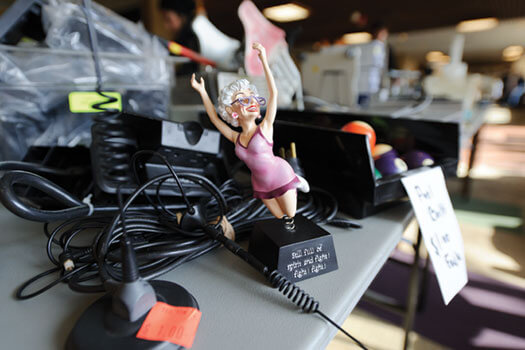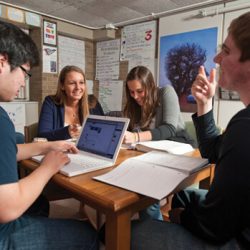Imagine a Business

This incongruous trophy was among the treasures students could snag for their projects while participating in this year’s 100-Hour Wiscontrepreneur Challenge. No matter an object’s original purpose, budding entrepreneurs excel at envisioning what it could become.
Creative ideas and a supportive campus culture are helping more and more students embrace the entrepreneurial spirit.
Michael Filbey x’13 is a natural-born businessperson. While other kids were playing with video games and Pokémon cards, he sold them online, certain he could turn a profit.
Filbey now owns Cbay, an online resale service that gives part of each sale’s profit to charity. For everything from a gazebo to a scuba suit, Filbey will pick up the item, list it for sale, ship it out, and then portion out the revenue — 60 percent to the original owner, 20 percent to the charity Wellspring, and 20 percent to reinvest in Cbay and grow his business.
With job prospects slim, more college students nationwide are turning to entrepreneurship to carve out their own post-graduation careers, and colleges are responding. More than two thousand American colleges now offer courses in entrepreneurship, teaching skills to students who are pursuing majors from art to education to engineering.
UW–Madison is no exception. Filbey says that much of the credit for his success goes to the time he spent in the Entrepreneurial Residential Learning Community — just one of the ways that the UW has expanded its support for budding entrepreneurs.
During the past five years, a major effort by the university to extend learning and funding opportunities to all corners of the campus has forced a major cultural shift. What was once an exclusive club of business students drafting plans for their potential companies and young researchers hoping to patent their latest discoveries is now open to all students with creative ideas and a drive to succeed, no matter their majors.
Perception about students who begin forming their own futures has changed, too. “It’s more of a viable career choice, rather than being looked at as not being able to hold down a job,” says Dan Olszewski ’87, director of the Weinert Center for Entrepreneurship in the Wisconsin School of Business. “Now they’re on the covers of magazines.”
Expanding on Tradition
The UW has always been an innovation incubator. It has buildings named for Stephen Babcock and Harry Steenbock, two of the campus’s most famous inventors, and the Wisconsin Alumni Research Foundation was founded in 1925 to manage the discoveries and inventions evolving from the university’s vast research enterprise. On the business side, the Weinert Center is one of the nation’s first academic programs focused on launching businesses. Its undergraduate program has been included in Entrepreneur magazine’s top twenty-five colleges every year since 2008, and its graduate program was ranked sixth in the nation by the Financial Times in 2010.
But until recently, the major entrepreneurship efforts on campus resided at opposite ends of the spectrum — the research lab and the business school — and ne’er the twain did meet. Science and engineering students couldn’t access the business classes they needed to learn how to market their innovations. Many business students lacked the technical know-how to bring their ideas to fruition. A lot of potential was simply being lost.
That began to change in 2007, thanks to a major grant from the Ewing Marion Kauffman Foundation. To promote its mission of entrepreneurship and economic independence, the foundation named select schools across the country as “Kauffman campuses,” and awarded funds to transform the way they teach entrepreneurship. UW–Madison received a five-year award of $3 million to break through boundaries and put the E-word on the tip of everyone’s tongue.
“We won the grant on the idea that we were going to follow the notion of the Wisconsin Idea and the fundamental missions of the campus, which are teaching, research, and service,” says Allen Dines, assistant director of the UW’s Office of Corporate Relations.
That objective grew into the Wiscontrepreneur initiative — a comprehensive way to foster entrepreneurship across the campus.

It’s a truly hands-on experience as students scramble to repurpose surplus materials into a “chill cup,” a freezer-pack-like cup to keep beverages cool — hoping to complete their project within the 100 hours allotted for the annual challenge.
Real-Life Learning
“We didn’t know [at first] how we were going to change the culture of the campus,” says Dines. “But we posited a lot of experiments, and we thought we knew a bit about entrepreneurial behavior. A good part of what we thought was important on the teaching and learning side was the whole experiential part of the education process.”
Academics were expanded in key ways, including three new certificate programs in entrepreneurship and a popular new course, Entrepreneurship in Society, which has drawn more than eight hundred students. But much of the UW’s entrepreneurial revolution took place in the practical realm — providing ways to introduce students firsthand to the tools they will need following graduation.
The university expanded existing campus activities — such as the G. Steven Burrill Business Plan Competition, in which students present full business plans to vie for grants up to $10,000 — to allow non-technology-based ideas. And it offered new opportunities: for example, the 100-Hour Wiscontrepreneur Challenge gathered dozens of students from across the campus in the basement of Sellery Hall on a Thursday in February. Their goal was to scoop up as many secondhand items as they could afford for fifteen dollars, carry away their treasures, and create something before one hundred hours elapsed.
Other initiatives included a competition for creative solutions to climate change; a challenge that awards funding for special events and other arts-related endeavors; and a boot camp designed to help graduate students understand how technology entrepreneurship could relate to their research.
One of the most important additions to the entrepreneurial campus environment, the Entrepreneurs’ Resource Clinic, opened at the new Wisconsin Institutes for Discovery building in 2011. It offers much-needed help — from legal aspects to financial advice — as students, faculty, staff, and community members work through the process of starting their own companies.
“[The clinic] is intended to be the … center of gravity for entrepreneurs on campus. We’ve pulled together the various groups around the campus that offer a service for entrepreneurs,” Dines says.
The clinic does triage for those who apply for help: some receive advice, others get referrals to outside services, and some are asked to return when they are further along in the process. More than 175 potential businesses came through the program during its first year, either to seek advice or mentorship, or to attend networking events and competitions.
The resource clinic doesn’t always mean the difference between success and failure, though. Its primary purpose is providing an opportunity to explore entrepreneurial thinking and helping each person come to the right decision.
“They don’t all progress, and that’s okay,” Dines says. “Sometimes the right direction is playing with an idea for a while and deciding, ‘Maybe I’m better off just getting a job somewhere.’ And that’s fine.”
Olszewski says hands-on learning has always been a fundamental element of the business school’s entrepreneurship curriculum. Unlike subjects such as geometry or finance, most of a budding business owner’s education will take place outside the classroom: grappling for investors and trying to make the most of limited resources.
“We have a lot of interaction between learning about the theory and the cases, as well as going out and actually seeing it in action,” says Olszewski. “And that’s been really powerful from a learning standpoint.”
Since the Weinert Center opened in 1986, Olszewski says, students have completed nearly one thousand projects with local businesses. Recently, a group of five students developed an entirely new business plan for the popular Brasserie V restaurant in Madison. Others worked with EchoMetrix, a biomedical engineering firm started by UW professor Hirohito Kobayashi, performing market research on existing and potential target audiences to help expand the business.
“[These are] all skills that a student will be able to use in the future in a company or new venture,” Olszewski explains. “This provides an experience in having to make recommendations with imperfect or conflicting information, and the knowledge that your decisions will have ramifications on the business.”
Living the Experience
CBay’s Michael Filbey admits that joining the Entrepreneurial Residential Learning Community (ERLC) was his mom’s idea, so naturally, he was resistant at first.
“I initially thought it would be a hotbed for nerdy, antisocial students — just to be frank,” he says. “Now I think the ERLC is just the greatest thing.”
As perhaps the most immersive example of Kauffman initiatives on campus, the ERLC in Sellery Hall houses sixty-plus undergraduates who share common career goals. It’s part of a network of learning communities within campus residential halls that groups students by common interests, such as environmental awareness, creative arts, or women studying science and engineering.
In addition to living in close quarters — which provide a natural setting for bouncing ideas off one another — ERLC students take a class together and hold monthly events to learn more about the current business climate from successful entrepreneurs. They are also encouraged to participate together in the campus’s many competitions, and they are eligible for exclusive grants to fund creative business ventures.
While he was an ERLC resident, Filbey received a $1,500 Dream Big Venture Proposal grant, which served as seed money for his company, helping him launch Cbay while still enrolled as a student. Other grants have funded ideas ranging from a social photography business to a research project on brine shrimp.
Although he acknowledges the critical role of funding, Filbey says the knowledge and faculty support he gained on campus was even more valuable. He came to college with a natural mind for business and an idea — but with much still to learn about navigating the intricate world of business.
“The ERLC is unique because of the investment of its faculty and staff, and the connection it maintains with the students who formerly lived on the floor and have since moved off campus,” says James Franzone, a coordinator for the program. “There are very few communities like this in the country, and I think even fewer with such a deep connection to faculty.”
For Filbey, it was that expert involvement that made all the difference. “You can learn what mistakes to avoid. You’re not born knowing that angel investors exist,” he says. “I do think that anybody can be an entrepreneur, but teaching augments your chances of success, for sure.”

To many of us, it’s a box of used rubber bands. But to a student team participating in the 100-Hour Wiscontrepreneur Challenge, it’s a gold mine for their work-in-progress: “Dorm Fit” — a low-budget, total-body fitness system crafted from surplus materials.
Lasting Changes
Those involved with implementing the five-year Kauffman grant, which has now run its course, are optimistic about the lasting contributions it has made.
“We think the culture has changed pretty substantially [on campus] over the last five years,” says Corporate Relations’ Dines.
But whatever students’ motivation — fame, fortune, or the desire to be their own bosses — the numbers tell the story as entrepreneurship continues to grow. Enrollment for UW introductory courses to earn a certificate in entrepreneurship grew from 50 students in spring 2010 to 156 in spring 2012. The Burrill Business Plan Competition set new participation records in 2011 and 2012. And the business school’s fundamental entrepreneurship courses? They are populated predominantly by students with non-business majors.
“When the Kauffman people came here for a site visit last year, one of the things that excited them the most was the way the business school here has opened up to embrace the campus at large,” says Dines. “It’s almost a 180-degree change from the way other business schools they spoke of embrace campuswide entrepreneurship. And yet, they’re doing it in a way that is mindful of different forms of entrepreneurial behavior, whether it be arts, social good, sustainability, or entertainment.”
Lesa Mitchell, a Kauffman Foundation vice president, says this idea of bringing people together across the disciplines initially drew the foundation to Madison, and the result has been fascinating.
“The grant was a great instigator for the campus, and [the UW] did some great things with it. We believe now that entrepreneurship will continue to flourish on its own,” she says.
Interest in entrepreneurship was always present on campus, says Dines, but now there are concrete ways for students to pursue their dreams.
“I don’t think you can really create the passion — I think you can create conditions that ignite it,” he says, noting that it’s up to the campus to kindle that enthusiasm and direct it. “That’s what a university is supposed to be all about.” n
Lydia Statz ’12, a former editorial intern for On Wisconsin, says her greatest entrepreneurial success to date came when an entire baseball team stopped by her lemonade stand the summer before third grade.
Published in the Fall 2012 issue



Comments
No comments posted yet.